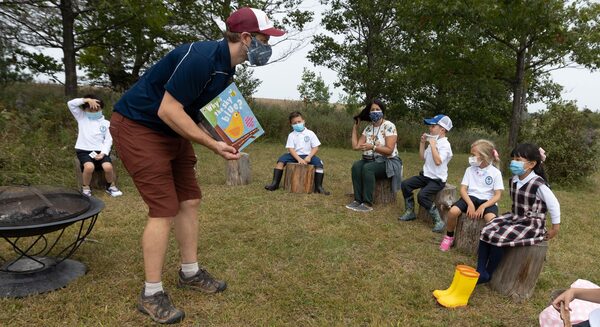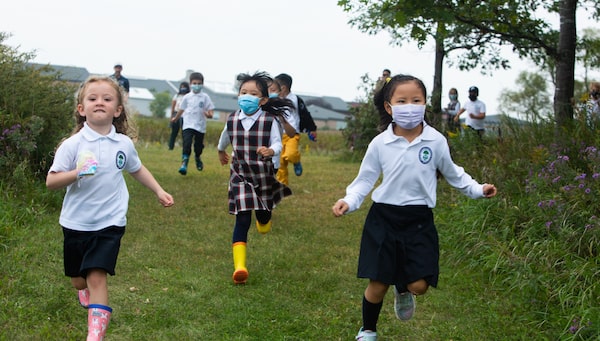
Country Day School teacher Andrew Bartle reads to students in their outdoor classroom. Outdoor education is an integral part of the private school’s curriculum, particularly during the pandemic.Glenn Lowson/The Globe and Mail
On an autumn day at the Country Day School, nestled within a swath of former farmland and wetlands in King City, Ont., you will find Grade 2 students learning about the local ecosystem by scouring the campus for animal tracks, while Grade 5 students study invasive species by removing pesky plants like purple loosestrife or phragmites. Senior students race on mountain bikes during physical education, while a math class studies in a new outdoor classroom — where desks, chairs and four walls are swapped for tree stumps and open air.
“On sunny days, the campus is really bustling,” says Andrew Bartle, one of CDS’s outdoor education teachers. “Even though we have 100 acres [40 hectares], it can be hard to find a quiet spot, which wasn’t the case before COVID.”
Outdoor education has always been an integral part of CDS’s curriculum, but during COVID-19, the JK-12 school has put an even greater emphasis on being outside. CDS built two new outdoor classrooms for teachers to bring their standard courses — like math, English or French — outside, and other courses are taking more advantage of the natural environment, like science classes being taught along the creek or in the forest.
“Rather than just reading or looking at photos in books, students are able to get hands-on and actually learn through active participation,” says Bartle.
Outdoors-based schools — or “nature schools” as they’re sometimes called — first started popping up in Scandinavia in the 1950s, eventually spreading across Europe and North America in the 1970s. During the pandemic, however, even more schools are bringing academics out of the classroom and into the great outdoors, where the virus is less transmissible.
St. Bonaventure’s College in St. John’s, N.L. built two new outdoor classrooms with whiteboards and tree stumps, and teamed up with Professor Jan Buley at Memorial University of Newfoundland to create an interdisciplinary program for students in Kindergarten to Grade 2 that focused on self-discovery.
“You might start a lesson outside studying soil, but all of a sudden a butterfly flies by and now the students have questions about butterflies, so they start researching them,” says David Martino, head of teaching and learning at St. Bonaventure’s. “Outdoor learning isn’t just about learning outside. It’s about reconnecting with the outdoors as a living experience and creating a deeper relationship with the subject matter.”
Martino has also seen first-hand how learning outdoors has improved students’ mental health. Students self-reported feeling happier and looked forward to their nature-based classes, which allowed for more experimentation than their typical classes.
“From a COVID perspective, we knew it was safer to be outside, but also from a mindfulness and wellness perspective, being outside and experiencing that spontaneity of learning also benefited students in a way that we realize should have a lasting impact.”

Outdoor education has always been an integral part of Country Day School's curriculum, but during COVID-19, the JK-12 school has put an even greater emphasis on being outside.Glenn Lowson/The Globe and Mail
The benefits of bringing nature into the classroom are well documented in research. Studies have shown that outdoor learning helps kids gain self-confidence, boosts childhood brain development and improves academic performance.
Carol Grant-Watt, the head of school of Strathcona-Tweedsmuir in Okotoks, Alta., believes that nature-based education also encourages students to start thinking about environmental issues from a young age.
“Students see the interconnectedness of our natural world,” says Grant-Watt. “We can help build life-long habits and appreciation of the environment. Not all families have the ability to provide those experiences, so if you can do it within a school, you can expose kids to these different opportunities.”
At Strathcona-Tweedsmuir, students participate in a range of outdoor activities, like hiking, cross-country skiing, rock climbing and canoeing. But the natural world is also infused throughout the curriculum for all grades. Drama classes rehearse and perform at the outdoor amphitheatre, poetry classes find inspiration on hiking trails and biology classes study at the pond.
The school’s outdoor classroom, dubbed Aspen Lodge, is tucked away in the woods and features floor-to-ceiling windows that fully open for warm days and a wood-burning stove for colder temperatures. Here, students can participate in yoga or mindfulness activities, or teachers can book out the space for their own courses. “It has this atmosphere that puts you in a place of possibility and creativity,” says Grant-Watt.
But nature-based learning doesn’t need to take place in a designated outdoor classroom or in the middle of the forest. It can happen anywhere outside.
During the pandemic, Toronto’s Upper Canada College has temporarily closed its Norval Outdoor School, the oldest outdoor education centre in Canada. Usually, students attend Norval for multi-day trips starting in Grade 3, where they sharpen their wilderness skills and participate in team building activities. Instead, UCC’s outdoor education curriculum was moved to the main campus downtown.
“When I was growing up in outdoor education, you might get one trip in Grade 6 where you go to an outdoor ed centre and then that would be it until Grade 8 or 9,” says Brent Evans, the director of Norval. “Now outdoor ed can be done anywhere. It can be done in a school yard like we’re trying at UCC, in a ravine, in a park or in your own backyard. Outdoor ed is the only subject that doesn’t tell you what you’re learning. It just tells you where you’re learning it.”
For Evans, who has taught outdoor education for more than a decade, the benefits of learning outdoors are endless: It sparks children’s natural curiosity, promotes a healthier lifestyle and increases confidence. Plus, it’s really fun.
“If a kid gets outside and sees all the different aspects of nature, even just for 20 minutes, it actually makes them healthier, so they learn more,” says Evans. “But they’ll also be happier. We want our kids to grow up happy and healthy. That is the ultimate goal.”
Looking for more stories about private school education? Get the latest on curriculum trends, financial assistance and the pandemic’s impact here.